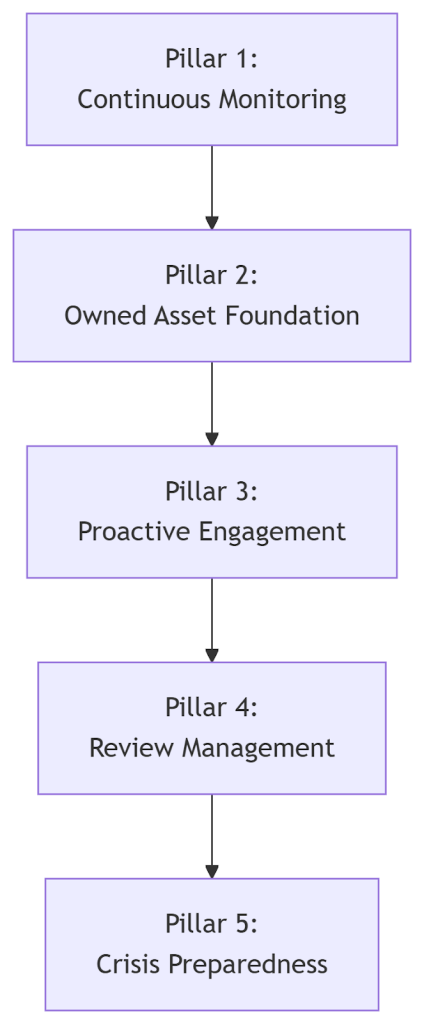
Imagine a potential client hears your company’s name for the first time. What’s the first thing they do? They search for you. In seconds, the results on their screen: reviews, news articles, social media posts, and your website, create a lasting first impression. This digital snapshot, accurate or not, becomes your truth in their eyes.
That snapshot is your online brand reputation. It’s the living, breathing narrative of your business written not by you, but by your customers, partners, and even strangers online. It shows up in Google search results, star ratings on review sites, social media comments, and forum discussions. Unlike a carefully crafted mission statement, this narrative is built in the open, one click, one comment, and one share at a time.
In an era where trust is built and broken online, managing this reputation isn’t a side task, it’s a core business strategy. This guide provides a blueprint for taking control: how to proactively build a credible digital presence, monitor conversations that matter, and protect your name when challenges inevitably arise.
What Is Online Brand Reputation? (It’s More Than Reviews)
At its core, online brand reputation is the perception people form of your business based on what they find about you on the internet. It’s not just a star rating on Google or Yelp, it’s the sum of every digital touchpoint that shapes trust and credibility.
When someone looks you up, they don’t see your carefully planned campaigns in isolation. They see a mosaic: search results, customer reviews, social media conversations, blog posts, press mentions, and even how you respond to criticism. Together, these fragments create a picture of who you are as a brand.
Unlike traditional advertising, online reputation is not entirely in your control. You can influence it, but you don’t own it. A single bad review, a viral tweet, or a negative news article can weigh heavily on public perception. On the flip side, positive mentions, thought leadership content, and authentic engagement can elevate your image and set you apart from competitors.
In short: online brand reputation is the digital first impression that defines whether people trust you enough to buy, recommend, or partner with you. Managing it well means actively shaping that impression, instead of leaving it to chance.
A strong brand reputation earns trust, fuels customer loyalty, and can even protect your business during tough times. It also directly ties into visibility, if people don’t know you, they can’t trust you. That’s why learning how to increase brand awareness goes hand in hand with reputation building.
The 5 Pillars of a Bulletproof Online Reputation
Building and protecting your reputation online isn’t about one-off fixes or reactive PR. It’s about creating a system that consistently reinforces trust, authority, and credibility across every digital channel. To do that, we use the five pillars of a bulletproof online reputation.
These pillars work together to cover every angle of your digital presence, from knowing what people say about you, to shaping how they find you, to protecting your name when things go wrong.

Together, these pillars form a comprehensive blueprint for not just surviving online but thriving with a reputation that attracts customers, partners, and talent.
If you want to see why modern approaches outperform traditional ads, check out the proven influencer marketing advantages that brands are already leveraging.
Pillar 1: Proactive Monitoring (Know What’s Being Said)
You can’t manage what you don’t measure. The first step in building a strong online brand reputation is knowing exactly what’s being said about your company, in real time. Reputation damage rarely comes from one bad review alone; it comes from missed opportunities to respond, clarify, or engage before things spiral.
Proactive monitoring gives you visibility. It helps you spot early signs of dissatisfaction, identify advocates worth amplifying, and understand the broader conversation shaping your brand’s perception.
How to Set Up Google Alerts for Your Brand & Executives
Google Alerts is a free, simple way to stay informed whenever your brand (or leadership team) is mentioned online.
- Go to Google Alerts.
- Enter terms like your brand name, product names, and the names of your executives.
- Use quotation marks for exact matches (e.g., “Hypefy”).
- Choose how often you’d like to be notified (daily, weekly, or as-it-happens).
It’s a low-cost starting point that ensures no major mention slips through the cracks.
Using Social Listening Tools to Track Sentiment
Mentions on social media move faster than traditional reviews. That’s where social listening tools come in. Platforms like Brand24, Mention, or Sprout Social allow you to:
- Track mentions of your brand across Twitter/X, Instagram, Facebook, TikTok, and forums.
- Gauge sentiment (positive, neutral, negative) to understand tone, not just volume.
- Spot trending topics or hashtags linked to your brand before they peak.
This type of monitoring goes beyond knowing when you’re mentioned, it helps you understand how people feel about you, which is critical for proactive reputation management.
The Essential Checklist: What to Monitor Daily/Weekly
A bulletproof monitoring system should cover all key touchpoints where customers interact or share opinions:
Daily:
- Reviews on Google, Yelp, Trustpilot, G2, or industry-specific sites.
- Social media mentions and direct tags.
- Brand-related hashtags.
Weekly:
- Blog posts, news articles, or PR mentions.
- Forum discussions and community boards.
- Employee review platforms like Glassdoor.
With a consistent monitoring routine, you won’t just be reacting, you’ll be anticipating and shaping the conversation around your brand.
Pillar 2: Search Engine Optimization (SEO) & Your Reputation
When someone searches your brand name, the first page of results is your digital business card. If it’s filled with positive, accurate, and authoritative content, people feel confident engaging with you. If negative press or outdated information dominates, your reputation takes a hit before you’ve had a chance to speak.
This is where SEO becomes more than just a traffic driver, it’s a reputation shield. By deliberately shaping what ranks for your brand queries, you can control the narrative and ensure people see your best side first.
How to Use Content and SEO to Control Search Results
Positive, well-optimized content can push down unhelpful or harmful results. Some tactics include:
- Create branded content hubs: Blog posts, press releases, and case studies that highlight customer success stories, thought leadership, or company updates.
- Optimize for branded queries: Make sure content that mentions your brand (e.g., “[Brand] reviews,” “[Brand] pricing”) answers questions honestly and positively.
- Leverage multiple formats: Videos, podcasts, and guest articles diversify your footprint and give search engines more positive assets to rank.
The more relevant, authoritative content you publish, the harder it becomes for negative results to dominate page one.
Claiming and Optimizing Your Google Business Profile & Other Directories
Your Google Business Profile (GBP) is often the first impression people get of your brand. An unclaimed or outdated profile can look unprofessional and lead to lost opportunities.
- Claim your profile (if you haven’t already).
- Update all details: hours, contact info, business category, and website.
- Upload high-quality visuals: logos, team photos, or product images.
- Encourage customer reviews and respond promptly.
Beyond Google, make sure your brand is listed consistently on other directories like Yelp, Bing Places, TripAdvisor, or industry-specific platforms. Consistency in name, address, and phone number (NAP) strengthens credibility both with search engines and customers.
Building Authoritative Backlinks to Strengthen Your Digital Footprint
Backlinks, links from other trusted websites to your content, act as votes of confidence in Google’s eyes. For reputation, they also signal credibility to readers.
- Pitch guest posts on reputable sites in your niche to showcase expertise.
- Publish PR-worthy content (research, reports, or thought leadership) that journalists and bloggers want to cite.
- Build partnerships with influencers or industry organizations that naturally link back to your brand.
High-quality backlinks improve your visibility, push down irrelevant or negative results, and ensure your brand shows up in the right contexts. With tools like Hypefy’s influencer discovery tool and outreach tool, you can identify the right creators and build partnerships that genuinely strengthen reputation.
Pillar 3: Proactive Content & Value Creation
Strong online brand reputation isn’t just about damage control, it’s about consistently creating value that builds credibility and trust long before problems arise. By publishing the right kind of content, you don’t just defend your reputation, you actively strengthen it.
Publishing Thought Leadership to Build Authority (E-E-A-T)
Search engines and audiences alike reward expertise. Under Google’s E-E-A-T framework (Experience, Expertise, Authoritativeness, Trustworthiness), publishing thought leadership content signals that your brand is a credible voice in its industry.
- Share data-backed insights, trend analyses, or case studies.
- Publish blogs, whitepapers, or research that educate rather than just sell.
- Encourage executives or specialists in your company to write LinkedIn posts, guest articles, or appear on podcasts.
The more you demonstrate authority in your field, the more people (and search engines) trust your brand.
Showcasing Customer Success Stories and Testimonials
One of the most powerful ways to build a positive reputation is to let your customers tell the story for you. Case studies, video testimonials, and social proof show real-world results and authentic satisfaction.
- Create short video testimonials highlighting customer experiences.
- Write case studies that focus on challenges solved, not just product features.
- Share snippets of positive reviews across your social channels or website.
When prospects see people like them finding success with your brand, it validates your credibility instantly.
Engaging Authentically on Social Media (Beyond Promotion)
Social media can be a megaphone for reputation, but only if you use it authentically. Instead of treating platforms like advertising billboards, use them as spaces to connect and converse.
- Respond thoughtfully to comments and questions, not just with canned replies.
- Share behind-the-scenes content to humanize your brand.
- Participate in relevant conversations and trending topics in ways that align with your values.
When audiences feel a real connection, they’re more likely to advocate for you, defend you in times of crisis, and share your content with their own networks.

Pillar 4: Managing Reviews & Customer Feedback
Reviews are often the first thing potential customers see when they search for your brand. A single one-star review can outweigh dozens of five-star ones if it’s left unaddressed. On the flip side, consistently positive reviews can become one of your strongest reputation assets. Managing this feedback, both good and bad, is essential to shaping how people perceive your business.
The Right Way to Respond to Positive and Negative Reviews (With templates)
Every review deserves a response. It shows customers that you’re listening and that you value their experience.
- Positive review response template:
“Thank you so much for your kind words, [Name]. We’re thrilled to hear you enjoyed [specific product/service], and we’ll be sure to share your feedback with our team. We look forward to serving you again!” - Negative review response template:
“Hi [Name], we’re sorry to hear about your experience with [specific issue]. We take this seriously and would like to make it right. Please reach out to us at [contact information] so we can resolve this quickly.”
By staying polite, professional, and solution-focused, you not only rebuild trust with the reviewer but also show future customers how you handle criticism.
How to (Ethically) Encourage More Positive Reviews
The best way to boost your reputation is to increase the volume of genuine, positive feedback. Some ethical tactics include:
- Following up purchases with a polite review request via email or SMS.
- Making it easy: provide direct links to your Google, Yelp, or industry-specific review pages.
- Encouraging satisfied customers to share their story, not just give a star rating.
- Offering excellent service first, happy customers are naturally more willing to leave reviews.
Avoid shortcuts like fake reviews or incentivized ratings, they damage credibility and can even lead to penalties.
When and How to Flag Fraudulent or Fake Reviews
Not every review is legitimate. Competitors, bots, or disgruntled ex-employees may attempt to harm your brand with false claims.
- Look for red flags: vague details, identical phrasing across multiple reviews, or suspicious spikes in negative reviews.
- Use platform tools: Google, Yelp, and most major review platforms allow you to report reviews that violate their policies.
- Respond transparently: If removal takes time, leave a short, professional reply clarifying the situation for readers.
Knowing how to identify and handle fake reviews ensures your reputation reflects real customer experiences, not fabricated ones.
Pillar 5: Crisis Response & Management
Even the most reputable brands face challenges, a product recall, a viral complaint, or a negative news story. What separates brands that recover from those that suffer long-term damage is how they respond. A well-prepared crisis strategy can prevent a single incident from defining your reputation.
Creating a Simple Crisis Communication Plan
You don’t need a 100-page manual, but you do need a clear plan that everyone on your team understands. At minimum, include:
- Defined roles: Who monitors, who drafts statements, who speaks publicly.
- Approval chain: A streamlined process to avoid delays.
- Communication channels: Decide whether the first response should go to social media, email, press, or directly to customers.
- Pre-approved templates: Draft short statements for common scenarios (shipping delays, product issues, service outages) that can be customized quickly.
A simple plan makes your team confident, fast, and consistent under pressure.
Step-by-Step: How to Respond to a PR Crisis Online
- Acknowledge quickly – Silence creates a vacuum that others will fill. Even a holding statement like, “We’re aware of the issue and are working on a solution” shows accountability.
- Be transparent – Share what you know, what caused it (if confirmed), and what you’re doing to fix it.
- Stay human – Avoid overly corporate or defensive language. Empathy goes further than perfection.
- Move conversations offline – Provide contact details for affected customers to resolve issues privately.
- Follow up – After resolving the issue, circle back with updates, showing not only that you fixed the problem but also that you learned from it.
Handled well, a crisis can actually strengthen trust by proving your brand’s integrity under pressure.
When to Seek Professional Online Reputation Management (ORM) Help
Some situations require outside expertise, especially if negative content is spreading quickly or dominating search results. Signs you may need professional help include:
- A damaging news article ranking on page one of Google.
- Coordinated attacks (fake reviews, bot-driven social campaigns).
- A major PR scandal affecting investors, partners, or employees.
ORM specialists can help suppress harmful content, improve search visibility for positive assets, and guide your brand through legal or technical complexities. Knowing when to escalate ensures small issues don’t snowball into long-term reputation damage.

Essential Online Brand Reputation Management Tools
Managing online brand reputation is much easier when you have the right technology in place. These tools help you monitor conversations, track reviews, and respond quickly before issues escalate. Depending on your budget and needs, you can start with free essentials or invest in advanced platforms.
Free Tools to Get Started (Google Alerts, Google Business Profile, Social Searcher)
- Google Alerts – A free tool that notifies you when your brand, executives, or products are mentioned across the web. Simple, effective, and quick to set up.
- Google Business Profile – Essential for local visibility. It lets you manage your information, collect and respond to reviews, and appear prominently in local search results.
- Social Searcher – A free monitoring tool that scans social media platforms for mentions of your brand, giving you basic insight into what’s being said.
These tools are a great entry point if you’re just starting to track your online presence.
Premium All-in-One Suites
If you’re ready for deeper insights and real-time tracking, all-in-one platforms provide advanced features:
- Meltwater – Offers comprehensive media monitoring across news, blogs, and social platforms, with strong analytics for PR teams.
- Brand24 – Focused on social listening, sentiment analysis, and competitor tracking, making it useful for mid-sized businesses.
- Determ – Provides AI-powered monitoring, alerts, and customizable dashboards for brands that want actionable insights at scale.
These tools go beyond mentions, they help you understand sentiment trends, measure share of voice, and benchmark against competitors.
Specialized Tools for Review Management
Reviews carry significant weight in online reputation. Dedicated platforms help you collect, manage, and display them more effectively:
- Yotpo – Enables brands to collect customer reviews, ratings, and user-generated content that can be displayed on websites or product pages.
- Trustpilot – A widely recognized review platform that builds credibility by showcasing verified customer feedback across industries.
- Birdeye – A comprehensive solution that combines review management with broader reputation monitoring, messaging, and surveys, aimed particularly at local businesses.
With review management tools, you can increase positive social proof, respond quickly to concerns, and ensure that customer voices become a core part of your reputation strategy.
Your Reputation is a Living Asset
Online brand reputation isn’t something you set once and forget, it’s dynamic, evolving with every review, search result, and social media mention. What people see online today shapes how they trust you tomorrow.
The strongest brands treat reputation as an ongoing investment. They monitor conversations, create valuable content, respond to feedback, and prepare for challenges before they happen. By consistently nurturing these efforts, you’re not just protecting your image, you’re building an asset that fuels customer loyalty, attracts talent, and strengthens partnerships.
Think of it this way: marketing campaigns may grab attention, but it’s your reputation that keeps people coming back. Manage it well, and your online presence becomes a powerful engine for long-term success.
If you’re ready to strengthen your online brand reputation, the best place to start is with how people talk about you. At Hypefy, our platform helps you build trust from the ground up by connecting with the right influencers, managing campaigns with clarity, and measuring impact, all without the chaos of spreadsheets.
Explore Hypefy and see how we make influencer campaigns simple, scalable, and reputation-friendly.



